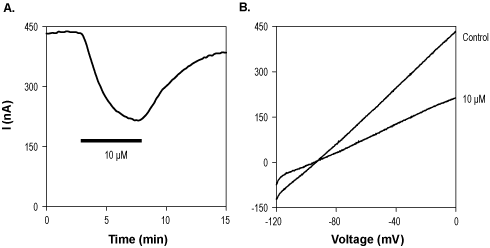Overview
- Bhave, G. et al. (2011) Mol. Pharmacol. 79, 42.
 Alomone Labs VU591 hydrochloride blocks Kir1.1 channels expressed in Xenopus oocytes.A. Kir1.1 channel currents were elicited by 150 ms voltage ramp from -120 mV to +60 mV (HP -90 mV, no leak subtraction). VU591 hydrochloride (#V-126) was applied at 10 µM as indicated and inhibited the Kir1.1 channel current in a reversible manner. B. Example current traces before and during application of 10 µM VU591 hydrochloride, from the experiment shown in A.
Alomone Labs VU591 hydrochloride blocks Kir1.1 channels expressed in Xenopus oocytes.A. Kir1.1 channel currents were elicited by 150 ms voltage ramp from -120 mV to +60 mV (HP -90 mV, no leak subtraction). VU591 hydrochloride (#V-126) was applied at 10 µM as indicated and inhibited the Kir1.1 channel current in a reversible manner. B. Example current traces before and during application of 10 µM VU591 hydrochloride, from the experiment shown in A.
VU591 hydrochloride is a potent and selective blocker of renal outer medullary potassium channel, ROMK (Kir1.1). Kir1.1 channel is a putative drug target for a novel class of loop diuretic drugs that hold the ability to lower pressure and blood volume without causing hypokalemia. VU591 seems to block the intracellular pore of the channel and does so with an IC50 of 300 nM.
ROMK channels are expressed in the thick ascending limb of Henle's loop, connecting tubule, and collecting duct segments of the nephron. They mediate K+ secretion into the urinary filtrate. ROMK provides K+ ions in the thick ascending limb that are necessary for NaCl reabsorption by the Na+-K+-2Cl− cotransporter and loop diuretic target. In the connecting tubule and collecting duct, ROMK constitutes a key pathway for K+ secretion.
Evidence shows that ROMK antagonists could serve as potent diuretic drugs by inhibiting Na+ reabsorption in the thick ascending limb of Henle's loop and minimizing urinary K+ ions loss in the collecting duct. Thus, administration of VU591, a direct diuretic, can avoid hypokalemia, a side effect caused from treatment of conventional loop and thiazide diuretics in cases of hypertension and congestive heart failure.

